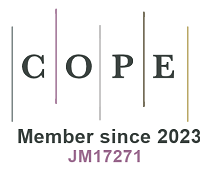REFERENCES
2. Jia S, Huang MJ, Zhang B, Wei ZY, Cheng H, Li SZ. Research progress of biomass based carbon materials in the treatment of dyeing wastewater. Chem Ind Forest Prod 2023;43:145-56.
3. Ou SF, Yang DS, Liao JW, Chen ST. Treating high COD dyeing wastewater via a regenerative sorption-oxidation process using a nano-pored activated carbon. Int J Mol Sci 2022;23:4752.
4. Kolya H, Kang CW. Toxicity of metal oxides, dyes, and dissolved organic matter in water: implications for the environment and human health. Toxics 2024;12:111.
5. de Freitas LVP, Silveira JGF, Damaceno MA, et al. Evaluating the persistence of malachite green residues in tilapia and pacu fish. Environ Toxicol Pharmacol 2024;106:104382.
6. Zahuri AA, Abdul Patah MF, Kamarulzaman Y, et al. Decolourisation of real industrial and synthetic textile dye wastewater using activated dolomite. Water 2023;15:1172.
7. Dissanayake NSL, Pathirana MA, Wanasekara ND, Mahltig B, Nandasiri GK. Removal of methylene blue and Congo red using a chitosan-graphene oxide-electrosprayed functionalized polymeric nanofiber membrane. Nanomaterials 2023;13:1350.
8. Nguyen DDD, Phan Quang HH, Nguyen XH, Nguyen TP. The treatment of real dyeing wastewater by the electro-Fenton process using drinking water treatment sludge as a catalyst. RSC Adv 2021;11:27443-52.
9. Dong H, Liu H, Yang X, et al. The effect of initial conditions with aerobic biological treatment on aniline dyeing wastewater. Processes 2021;9:1329.
10. Lin X, Zhou Q, Xu H, Chen H, Xue G. Advances from conventional to biochar enhanced biotreatment of dyeing wastewater: a critical review. Sci Total Environ 2024;907:167975.
11. Deng D, Lamssali M, Aryal N, Ofori-Boadu A, Jha MK, Samuel RE. Textiles wastewater treatment technology: a review. Water Environ Res 2020;92:1805-10.
12. Xue T, Shao F, Miao H, Li X. Porous polymer magnetic adsorbents for dye wastewater treatment. Environ Sci Pollut Res Int 2023;30:97147-59.
13. He Y, Ni L, Gao Q, et al. Activated carbon with ultrahigh specific surface derived from bamboo shoot shell through K2FeO4 oxidative pyrolysis for adsorption of methylene blue. Molecules 2023;28:3410.
14. Castaldo R, Avolio R, Cocca M, Errico ME, Avella M, Gentile G. Amino-functionalized hyper-crosslinked resins for enhanced adsorption of carbon dioxide and polar dyes. Chem Eng J 2021;418:129463.
15. Chen S, Tang S, Sun Y, et al. Preparation of a highly porous carbon material based on quinoa husk and its application for removal of dyes by adsorption. Materials 2018;11:1407.
16. Song J, Deng Q, Huang M, Kong Z. Carbon nanotube enhanced membrane distillation for salty and dyeing wastewater treatment by electrospinning technology. Environ Res 2022;204:111892.
17. Boulanger N, Talyzin AV, Xiong S, Hultberg M, Grimm A. High surface area activated carbon prepared from wood-based spent mushroom substrate for supercapacitors and water treatment. Colloid Surfaces A 2024;680:132684.
18. Lu J, Zhang Q, An Q, et al. Preparation of activated carbon from sewage sludge using green activator and its performance on dye wastewater treatment. Environ Technol 2023;44:3897-910.
19. Li L, Ai J, Zhang W, et al. Relationship between the physicochemical properties of sludge-based carbons and the adsorption capacity of dissolved organic matter in advanced wastewater treatment: effects of chemical conditioning. Chemosphere 2020;243:125333.
20. Gong Y, Liu F, Liu H, Wang H, Zhao Y, Lin Y. Technology transition strategies for textile-dyeing sludge management in China from the environmental and economic perspectives. Sustain Prod Consump 2023;43:363-76.
21. Gao J, Zhou Y, Yang X, et al. Dyeing sludge-derived biochar for efficient removal of antibiotic from water. Sci Total Environ 2024;912:169035.
22. Fan Z, Zhou X, Peng Z, et al. Co-pyrolysis technology for enhancing the functionality of sewage sludge biochar and immobilizing heavy metals. Chemosphere 2023;317:137929.
23. Chen C, Sun J, Li Y, Zhao X, Wu H. Adsorption of methylene blue on activated carbon prepared from printing sludge. Chin J Environ Eng 2018;12:1872-8. Available from: http://eekw.rcees.ac.cn/en/article/doi/10.12030/j.cjee.201710068. [Last accessed on 24 Jul 2024]
24. Wong S, Ngadi N, Inuwa IM, Hassan O. Recent advances in applications of activated carbon from biowaste for wastewater treatment: a short review. J Clean Prod 2018;175:361-75.
25. Zhang H, Wei Z, Xiong D, et al. Investigation into the structure and properties of biochar co-activated by ZnCl2 and NaHCO3 under low temperature conditions. Materials 2024;17:942.
26. Oke N, Mohan S. Development of nanoporous textile sludge based adsorbent for the dye removal from industrial textile effluent. J Hazard Mater 2022;422:126864.
27. Wei S, Zhu M, Fan X, et al. Influence of pyrolysis temperature and feedstock on carbon fractions of biochar produced from pyrolysis of rice straw, pine wood, pig manure and sewage sludge. Chemosphere 2019;218:624-31.
28. Moško J, Pohořelý M, Skoblia S, et al. Structural and chemical changes of sludge derived pyrolysis char prepared under different process temperatures. J Anal Appl Pyrol 2021;156:105085.
29. Zou J, Yu J, Tang L, et al. Analysis of reaction pathways and catalytic sites on metal-free porous biochar for persulfate activation process. Chemosphere 2020;261:127747.
30. Wang RZ, Huang DL, Liu YG, et al. Recent advances in biochar-based catalysts: properties, applications and mechanisms for pollution remediation. Chem Eng J 2019;371:380-403.
31. Thue PS, Lima DR, Lima EC, et al. Comparative studies of physicochemical and adsorptive properties of biochar materials from biomass using different zinc salts as activating agents. J Environ Chem Eng 2022;10:107632.
32. Ferraro A, Marino E, Trancone G, et al. Assessment of environmental parameters effect on potentially toxic elements mobility in foreshore sediments to support marine-coastal contamination prediction. Mar Pollut Bull 2023;194:115338.
33. Wang X, Li C, Li Z, Yu G, Wang Y. Effect of pyrolysis temperature on characteristics, chemical speciation and risk evaluation of heavy metals in biochar derived from textile dyeing sludge. Ecotoxicol Environ Saf 2019;168:45-52.
34. Liang X, Ning X, Lin C, et al. Optimization of preparation conditions for activated carbons from textile dyeing sludge and sawdust using response surface methodology based on CCD. Chin J Environ Eng 2014;8:4937-42. Available from: http://hjhx.rcees.ac.cn/en/article/id/20141161?viewType=HTML. [Last accessed on 24 Jul 2024].
35. Zhao WX, Zhou JY, Chen L, Zhang H, Bao K, Wan J. Preparation and adsorption and catalytic performance of municipal sludge biochar. Chem Res Appl 2022;34:2531-7. Available from: https://cstj.cqvip.com/Qikan/Article/Detail?id=7108273947&from=Qikan_Search_Index. [Last accessed on 24 Jul 2024]
36. Varela CF, Moreno-aldana L, Agámez-pertuz YY. Adsorption of pharmaceutical pollutants on ZnCl2-activated biochar from corn cob: efficiency, selectivity and mechanism. J Bioresour Bioprod 2024;9:58-73.
37. Li Y, Chang F, Huang B, Song Y, Zhao H, Wang K. Activated carbon preparation from pyrolysis char of sewage sludge and its adsorption performance for organic compounds in sewage. Fuel 2020;266:117053.
38. Mahapatra U, Chatterjee A, Das C, Manna AK. Chemically activated carbon preparation from natural rubber biosludge for the study of characterization, kinetics and isotherms, thermodynamics, reusability during Cr(VI) and methylene blue adsorption. Water Sci Technol 2023;87:635-59.
39. Jian H, Yang F, Gao Y, et al. Efficient removal of pyrene by biochar supported iron oxide in heterogeneous Fenton-like reaction via radicals and high-valent iron-oxo species. Sep Purif Technol 2021;265:118518.
40. Chen J, Bai X, Yuan Y, Zhang Y, Sun J. Printing and dyeing sludge derived biochar for activation of peroxymonosulfate to remove aqueous organic pollutants: activation mechanisms and environmental safety assessment. Chem Eng J 2022;446:136942.
41. Zhai S, Li M, Wang D, Ju X, Fu S. Cyano and acylamino group modification for tannery sludge bio-char: enhancement of adsorption universality for dye pollutants. J Environ Chem Eng 2021;9:104939.
42. Li K, Lu H, Zhang Q, Li J. Adsorption of Cd(II) and Cu(II) onto clay modified with sludge activated carbon. KSCE J Civ Eng 2020;24:1706-16.
43. Wang B, Zhai Y, Wang T, et al. Fabrication of bean dreg-derived carbon with high adsorption for methylene blue: effect of hydrothermal pretreatment and pyrolysis process. Bioresour Technol 2019;274:525-32.
44. Xiao J, Wang L, Ran J, Zhao J, Tao M, Zhang W. Highly selective removal of cationic dyes from water by acid-base regulated anionic functionalized polyacrylonitrile fiber: fast adsorption, low detection limit, reusability. React Funct Polym 2020;146:104394.
45. Oladoye PO, Ajiboye TO, Wanyonyi WC, Omotola EO, Oladipo ME. Insights into remediation technology for malachite green wastewater treatment. Water Sci Eng 2023;16:261-70.
46. Maiti P, Mangsatabam M, Chatterjee A, Siddiqi H, Mishra A, Meikap B. In-situ synthesis of efficient ZnCl2 doped pyrolyzed biochar for adsorptive remediation of organic dyes: performance evaluation, mass transfer and mechanism. Sep Purif Technol 2024;329:125096.
47. Azim E, Samy M, Hanafy M, Mahanna H. Novel mint-stalks derived biochar for the adsorption of methylene blue dye: effect of operating parameters, adsorption mechanism, kinetics, isotherms, and thermodynamics. J Environ Manage 2024;357:120738.
48. Pirbazari A, Saberikhah E, Badrouh M, Emami MS. Alkali treated Foumanat tea waste as an efficient adsorbent for methylene blue adsorption from aqueous solution. Water Res Ind 2014;6:64-80.
49. Tang SH, Zaini MAA. Microporous activated carbon prepared from yarn processing sludge via composite chemical activation for excellent adsorptive removal of malachite green. Surf Interfaces 2021;22:100832.
50. Leng L, Yuan X, Huang H, et al. Bio-char derived from sewage sludge by liquefaction: characterization and application for dye adsorption. Appl Surf Sci 2015;346:223-31.
51. Zeng H, Qi W, Zhai L, Wang F, Zhang J, Li D. Magnetic biochar synthesized with waterworks sludge and sewage sludge and its potential for methylene blue removal. J Environ Chem Eng 2021;9:105951.
52. Raj A, Yadav A, Rawat AP, et al. Kinetic and thermodynamic investigations of sewage sludge biochar in removal of remazol brilliant blue R dye from aqueous solution and evaluation of residual dyes cytotoxicity. Environ Technol Innov 2021;23:101556.
53. Dai Q, Liu Q, Zhang X, et al. Synergetic effect of co-pyrolysis of sewage sludge and lignin on biochar production and adsorption of methylene blue. Fuel 2022;324:124587.
54. Li Y, Zhao M, Yan H, et al. Silica from rice husk for sludge-based biochar modification: as a novel adsorbent for lead. J Water Process Eng 2024;60:105218.
55. Zhao Z, Sun W, Ray MB. Adsorption isotherms and kinetics for the removal of algal organic matter by granular activated carbon. Sci Total Environ 2022;806:150885.
56. Li H, Kong J, Zhang H, et al. Mechanisms and adsorption capacities of ball milled biomass fly ash/biochar composites for the adsorption of methylene blue dye from aqueous solution. J Water Process Eng 2023;53:103713.
57. Chen Y, Li M, Li Y, et al. Hydroxyapatite modified sludge-based biochar for the adsorption of Cu2+ and Cd2+: adsorption behavior and mechanisms. Bioresour Technol 2021;321:124413.
58. Gayathiri M, Pulingam T, Lee KT, Sudesh K. Activated carbon from biomass waste precursors: factors affecting production and adsorption mechanism. Chemosphere 2022;294:133764.
59. Qu J, Wang Y, Tian X, et al. KOH-activated porous biochar with high specific surface area for adsorptive removal of chromium (VI) and naphthalene from water: affecting factors, mechanisms and reusability exploration. J Hazard Mater 2021;401:123292.
60. Zhang W, Du W, Wang F, et al. Comparative study on Pb2+ removal from aqueous solutions using biochars derived from cow manure and its vermicompost. Sci Total Environ 2020;716:137108.
61. Liu C, Li H, Ni JQ, et al. Effect of municipal sludge-based biochar produced at different pyrolysis temperatures on humification and oxytetracycline degradation of pig manure composting. Sci Total Environ 2024;906:167816.
62. Zhao W, Zhao Y, Zhang H, Hao C, Zhao P. Efficient removal of cationic and anionic dyes by surfactant modified Fe3O4 nanoparticles. Colloid Surfaces A 2022;633:127680.
63. Wu JL, He H, Huang JY, Chen YR, Zhang WJ, Wang DS. Preparation of dyeing sludge-based carbon and its adsorption characteristics of dissolved organic matter in dredged residual water. Saf Environ Eng 2022;29:174-82.







